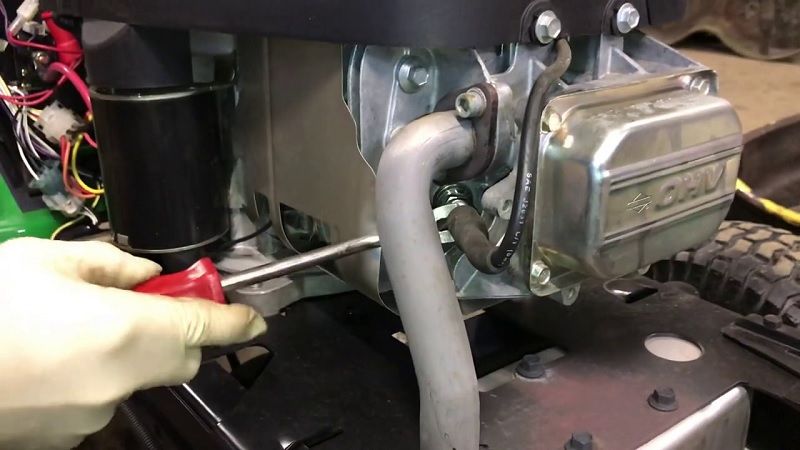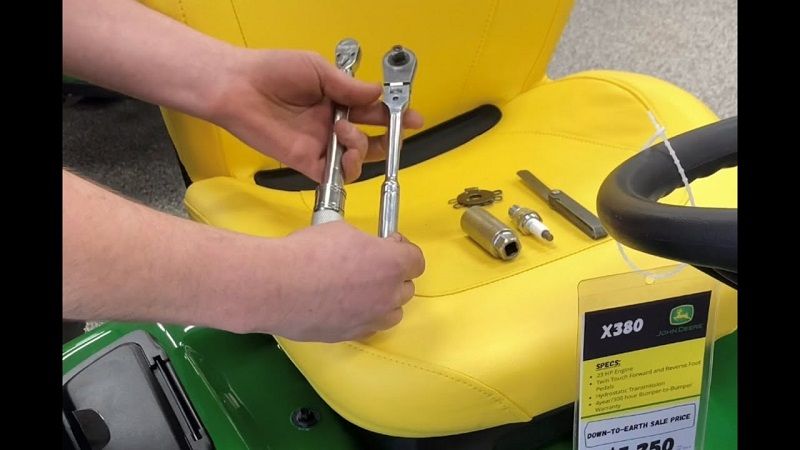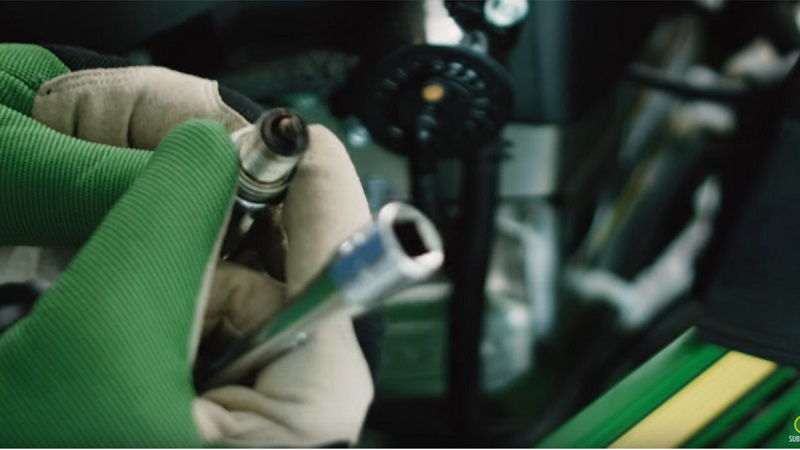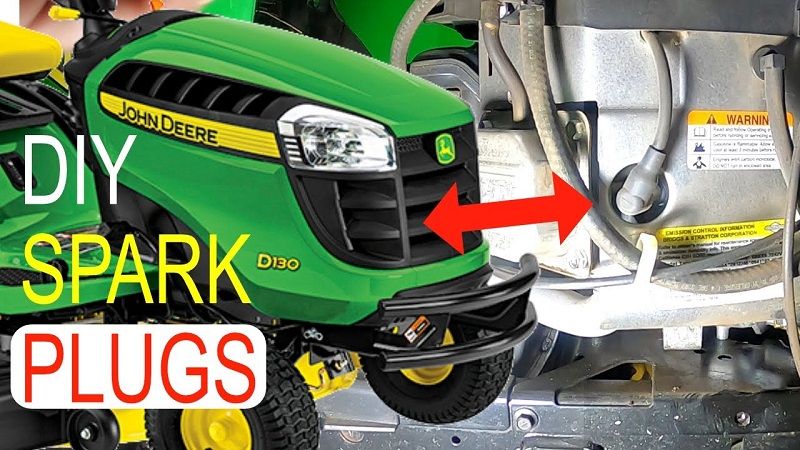This post contains affiliate links. This means I will make a commission at no extra cost to you should you click through and make a purchase [ “As an Amazon Associate, I earn from qualifying purchases.” ]. Read the full disclosure here.
John Deere Spark Plug Replacement GuideMechanic.Com When it comes to maintaining your John Deere equipment, spark plug replacement is an essential task that ensures optimal performance and longevity.
Whether you own a tractor, lawnmower, or any other John Deere machine, understanding the process of spark plug replacement is crucial.
This blog article will provide you with a detailed and comprehensive guide on how to replace spark plugs in your John Deere equipment, ensuring that you can keep it running smoothly for years to come.
In this guide, we will cover everything you need to know about John Deere spark plug replacement. From understanding the importance of regular maintenance to step-by-step instructions, you’ll find all the necessary information to perform this task efficiently.
Additionally, we’ll provide you with some valuable tips and tricks to make the process easier and more effective.
Why is Spark Plug Replacement Important?

Spark plug replacement is a vital part of regular maintenance for your John Deere equipment. The spark plug plays a crucial role in the combustion process by igniting the fuel-air mixture in the engine cylinder.
Over time, spark plugs can wear out, leading to reduced performance, misfires, and decreased fuel efficiency.
See Also: HQT 1 Spark Plug Cross Reference
By replacing the spark plugs at recommended intervals, you can ensure that your John Deere equipment continues to run smoothly, maintains its power, and operates at its peak performance.
Improved Performance
A worn-out spark plug can cause engine misfires and a decrease in power. By replacing the spark plugs, you restore the proper ignition process, resulting in improved performance.
Your John Deere equipment will run more smoothly, providing optimal power and efficiency for tasks such as mowing, tilling, or hauling.
Enhanced Fuel Efficiency
Old, inefficient spark plugs can lead to incomplete combustion, wasting fuel and reducing fuel efficiency. By replacing the spark plugs, you ensure that the fuel-air mixture ignites properly, maximizing the combustion process and improving fuel efficiency. This not only saves you money on fuel costs but also reduces harmful emissions.
Prevention of Costly Repairs
Regular spark plug replacement helps prevent potential damage to other engine components. Faulty spark plugs can cause stress on ignition coils and other ignition system parts.
By replacing the spark plugs on time, you avoid costly repairs and extend the overall lifespan of your John Deere equipment.
Signs of a Faulty Spark Plug
Recognizing the signs of a faulty spark plug is important in determining when it needs replacement. Below are some common symptoms that indicate your spark plug may be worn out:
Engine Misfires
If you notice your John Deere equipment engine misfiring, where it runs unevenly or has a rough idle, it could be a sign of a faulty spark plug. Misfires occur when the spark plug fails to ignite the fuel-air mixture properly. Replacing the spark plugs can often resolve this issue.
Difficulty Starting the Engine
A worn-out spark plug can make it challenging to start your equipment’s engine. If you experience difficulty starting or a prolonged cranking time, it may be time to replace the spark plugs. Faulty spark plugs can prevent the engine from firing up efficiently.
Poor Fuel Efficiency
If you notice a decrease in fuel efficiency and an increase in fuel consumption, it may be due to worn-out spark plugs.
Inefficient combustion caused by faulty spark plugs can lead to incomplete fuel burning, resulting in reduced mileage and higher fuel costs.
Engine Surges or Hesitation
When a spark plug is worn or damaged, it can cause engine surges or hesitation during acceleration. This occurs because the spark plug fails to provide a consistent spark, affecting the engine’s power delivery. Replacing the spark plugs can help resolve these issues.
Gathering the Necessary Tools and Materials

Before you begin replacing the spark plugs in your John Deere equipment, it’s essential to gather all the necessary tools and materials.
Having everything prepared in advance will make the process smoother and more efficient. Here are the tools and materials you will need:
Spark Plug Socket
A spark plug socket is specifically designed to fit over the spark plug, allowing for easy removal and installation. It typically has a rubber insert to securely hold the spark plug without damaging it.
Ratchet or Socket Wrench
You’ll need a ratchet or socket wrench to turn the spark plug socket and remove the spark plugs from your John Deere equipment. Ensure the size of the ratchet or socket wrench matches the spark plug socket.
See Also: Spark Plug Wires Replacement
Spark Plug Gap Tool
A spark plug gap tool is used to measure and adjust the gap between the spark plug electrodes. It ensures that the gap matches the manufacturer’s specifications, allowing for optimal spark plug performance.
New Spark Plugs
It’s important to have a set of new spark plugs that are specifically recommended for your John Deere equipment.
Check the owner’s manual or consult with a John Deere dealer to ensure you purchase the correct spark plugs for your specific model.
Anti-Seize Compound
An anti-seize compound helps prevent the spark plugs from seizing or sticking in the engine cylinder head. It’s a lubricating substance that is applied to the spark plug threads before installation.
Spark Plug Gap Measurement
Before installing the new spark plugs, it’s crucial to measure the gap between the electrodes. The spark plug gap measurement tool will allow you to check if the gap matches the manufacturer’s specifications. You may need to adjust the gap using the spark plug gap tool.
Locating the Spark Plugs in Your John Deere Equipment

The location of the spark plugs in your John Deere equipment may vary depending on the model and type of machine. Here are some common locations where you can find the spark plugs:
Tractors
In most John Deere tractors, the spark plugs are located on the sides of the engine cylinder head. They are often accessible from the top of the engine compartment or through removable panels. Refer to your tractor’s owner’s manual or consult with a John Deere dealer for the exact location.
Lawnmowers
On John Deere lawnmowers, the spark plugs are typically located on the engine housing. You may need to remove a protective cover or air filter housing to access them. Consult your lawnmower’s owner’s manual for specific instructions on locating the spark plugs.
Other Equipment
If you own other types of John Deere equipment, such as snow blowers, generators, or utility vehicles, the spark plugs can usually be found on the engine cylinder head. Check the owner’s manual or consult with a John Deere dealer for the exact location.
Preparing Your Equipment for Spark Plug Replacement
See Also: 2007 Honda Accord Spark Plugs
Before you start the spark plug replacement process, it’s important to prepare your John Deere equipment properly. Here are the steps to follow:
1. Ensure Safety
Prioritize your safety by turning off the engine and allowing it to cool down completely. Disconnect the spark plug wires from the existing spark plugs to prevent accidental engine firing during the replacement process.
2. Clean the Area
Remove any debris or dirt around the spark plug area using a brush or compressed air. This prevents dirt from falling into the engine cylinder when you remove the spark plugs.
3. Remove Obstacles
If there are any components blocking your access to the spark plugs, such as air filter housings or engine covers, remove them carefully. This will allow you to have a clear view and easy access to the spark plugs.
Removing the Old Spark Plugs
Now that you have prepared your John Deere equipment, it’s time to remove the old spark plugs. Follow these steps:
1. Locate the Spark Plug Wires
Identify the spark plug wires connected to the spark plugs. Depending on your equipment, there may be one wire per spark plug or a single wire connected to a distributor or ignition coil that leads to multiple spark plugs.
2. Remove the Spark Plug Wire
Gently grasp the spark plug wire boot, which is the rubber part covering the spark plug connection. Twist it slightly and pull it firmly away from the spark plug. Avoid pulling on the wire itself to prevent damage.
3. Clean the Spark Plug Area
Before removing the old spark plug, use compressed air or a soft brush to clean the area around the spark plug. This prevents dirt or debris from falling into the cylinder when you remove the plug.
4. Remove the Old Spark Plug
Attach the spark plug socket to the ratchet or socket wrench. Insert the socket over the spark plug and turn it counterclockwise to loosen and remove the old spark plug from the engine cylinder head.
5. Inspect the Old Spark Plug
Take a close look at the removed spark plug. Check the electrode condition, color, and signs of damage or wear.
This inspection can provide valuable insights into the engine’s condition and helpdetermine if there are any underlying issues that need to be addressed. If the spark plug appears worn, fouled, or damaged, it confirms the need for replacement.
Inspecting and Cleaning the Spark Plugs
Once you have removed the old spark plugs from your John Deere equipment, it’s important to inspect and clean them before installing the new ones. Follow these steps:
1. Visual Inspection
Examine the spark plugs for any signs of damage, such as cracks, corrosion, or excessive wear. Pay attention to the electrode condition and the color of the insulator. If you notice any abnormalities, it indicates that the spark plug needs replacement.
2. Cleaning the Spark Plugs
If the spark plugs appear dirty or have carbon deposits, they can be cleaned using a wire brush or a spark plug cleaner tool.
See Also: NGK BPM8Y Cross Reference
Gently brush the electrodes and insulator to remove any built-up debris or carbon. Ensure you do not damage the electrodes or insulator during the cleaning process.
3. Inspecting the Spark Plug Gap
Using a spark plug gap tool, measure the gap between the center electrode and the ground electrode. Compare the measurement to the manufacturer’s specifications for your specific John Deere equipment model. If the gap is too wide or too narrow, you will need to adjust it using the spark plug gap tool.
4. Adjusting the Spark Plug Gap
If the gap is not within the recommended range, carefully bend the ground electrode to widen or narrow the gap. Be gentle to avoid damaging the spark plug. Recheck the gap after adjustment to ensure it matches the manufacturer’s specifications.
Properly Gapping the New Spark Plugs
When replacing the spark plugs in your John Deere equipment, it’s essential to ensure that the new spark plugs have the correct gap. Follow these steps to properly gap the new spark plugs:
1. Check the Manufacturer’s Specifications
Refer to your John Deere equipment’s owner’s manual or consult with a John Deere dealer to determine the manufacturer’s recommended spark plug gap for your specific model. This information is crucial for optimal performance.
2. Measure the Gap
Using a spark plug gap tool, measure the gap between the center electrode and the ground electrode of each new spark plug. Ensure that the gap matches the manufacturer’s specifications. If the gap is too wide or narrow, adjust it accordingly.
3. Adjusting the Gap
To adjust the gap, gently bend the ground electrode with a spark plug gap tool. Be careful not to apply too much force, as it can damage the spark plug. Continue adjusting and rechecking the gap until it matches the recommended measurement.
4. Recheck the Gap
After adjusting the gap, recheck it to ensure it remains within the recommended range. It’s important to have consistent and accurate spark plug gaps to guarantee efficient combustion and proper ignition in your John Deere equipment.
Installing the New Spark Plugs
Now that you have inspected, cleaned, and properly gapped the new spark plugs, it’s time to install them in your John Deere equipment. Follow these steps for a successful installation:
1. Apply Anti-Seize Compound
Before installing the new spark plugs, apply a small amount of anti-seize compound to the threads. This compound helps prevent the spark plugs from seizing or sticking in the engine cylinder head, making future removal easier.
2. Hand-Tighten the Spark Plugs
Start by hand-threading the new spark plugs into the engine cylinder head. Rotate each spark plug clockwise until it is snug. Avoid overtightening, as it can damage the threads or the spark plug itself.
3. Final Tightening with a Ratchet
Using a ratchet or socket wrench, tighten the spark plugs further by turning them clockwise. Be cautious not to overtighten, as it can lead to thread damage. Refer to the manufacturer’s specifications or consult with a John Deere dealer for the recommended torque value.
4. Reconnect the Spark Plug Wires
Reattach the spark plug wires to the corresponding spark plugs. Firmly push the spark plug wire boot onto the spark plug until you hear or feel a click, indicating a secure connection. Double-check that each wire is properly seated.
Testing and Verifying Spark Plug Replacement
After successfully replacing the spark plugs in your John Deere equipment, it’s crucial to test and verify their proper functioning. Follow these steps to ensure everything is in order:
1. Reconnect the Battery (if applicable)
If you had disconnected the battery during the spark plug replacement process, reconnect it and ensure a secure connection. This ensures that the engine’s electrical system is functioning properly.
2. Start the Engine
Crank the engine and start it. Observe how the engine runs and listen for any unusual noises. The engine should start smoothly and run evenly without misfires or hesitation.
3. Check for Proper Idling
Allow the engine to idle for a few minutes and check if it maintains a steady and smooth idle. If there are no irregularities, it indicates that the new spark plugs are functioning correctly.
4. Perform a Test Run
Take your John Deere equipment for a test run, engaging it in the specific tasks it is designed for. Observe its performance, power delivery, and fuel efficiency. If everything is functioning optimally, it confirms the success of the spark plug replacement.
5. Monitor Performance
After the test run, continue to monitor the performance of your John Deere equipment over the next few days or weeks.
See Also: Torch F6RTC Spark Plug Cross Reference
Pay attention to any changes in power, fuel efficiency, or unusual engine behavior. If you notice any issues, it may indicate a need for further inspection or adjustment.
In conclusion, regular spark plug replacement is crucial for maintaining the performance and longevity of your John Deere equipment.
By following this comprehensive guide, you are equipped with the knowledge and skills to replace spark plugs efficiently.
Don’t overlook this essential maintenance task, as it can greatly impact the overall performance and efficiency of your beloved John Deere machine!
Related video of John Deere Spark Plug Replacement: A Comprehensive Guide for Efficient Maintenance
- Custom Lifted Diesel Trucks for Sale - December 20, 2025
- New Lifted Diesel Trucks for Sale - December 19, 2025
- Old Lifted Diesel Trucks for Sale - December 18, 2025

